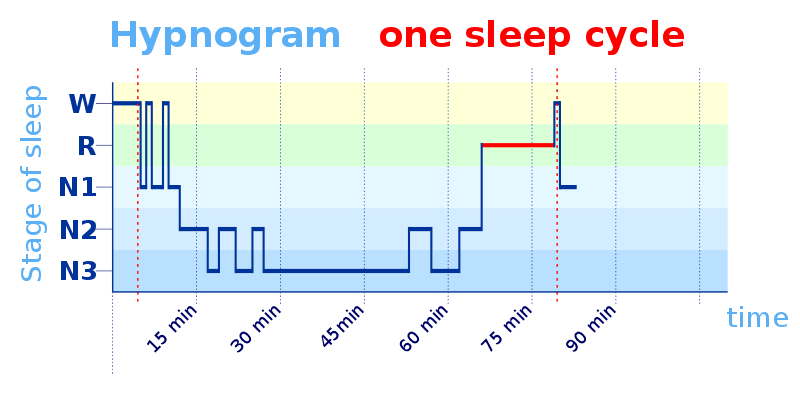Experts say that we’ll spend about a third of our lives sleeping. But just what happens when we catch those Z’s? While science doesn’t fully understand the whys and hows, we still know a bit about what happens during the various stages of sleep.
Let’s break it down, stage by stage.
Demystifying the Sleep Cycle

When we get a full night’s sleep, we’re actually experiencing a collection of about 4-5 sleep cycles; each one lasts roughly 90 minutes long. A single sleep cycle is composed of slow-wave sleep (SWS), rapid eye movement (REM) sleep, and brief periods of awakening. The American Academy of Sleep Medicine (AASM) further divides SWS, also known as non-REM (NREM) sleep, into three stages.
A complete sleep cycle roughly corresponds to the following pattern:
N1 —> N2 —> N3 —> N2 —> REM —> Brief Period of Awakening
Now that we’ve covered the basics, let’s get into the nitty-gritty of each stage.
What Happens During NREM Sleep?
The 3 NREM stages are often shortened to N1, N2, and N3. Each stage draws you into increasingly deeper sleep, which means slower brainwaves, lower body temperature, relaxed muscles, and slowing heartbeat and breathing. While most dreaming occurs during the REM stage, it’s still possible to dream some during NREM stages.[1]
What happens during each NREM stage?
N1 is the stage where you first start falling asleep. The first slowing of brainwaves noticeably marks this stage. This stage may last about 1-7 minutes.
N2 is a lighter sleep. While brain activity continues to slow, there are a few electrical bursts in the brain. Lighter sleep also entails the slowing of your heartbeat and breathing, a slight drop in body temperature, and the relaxing of your muscles. The first period of N2 may last 10-25 minutes.
N3 is known as deep sleep. Brainwaves, breathing, and heartbeat are slowest during N3. N3 is noticeably the hardest stage from which to awaken; when awoken from this stage, people will likely be incredibly groggy. This period lasts roughly 20-40 minutes and is briefly followed by 5-10 minutes of N2 before REM sleep begins.[2]
What Happens During REM Sleep?

REM sleep is noticeable for being the period where we dream the most. It is so named because our eyes move during this stage. Moving from N2 to REM involves a rise in blood pressure, breathing, and heartbeat. Inside the brain, you’ll find lots of the chemical acetylocholine but little to no histamine, serotonin, or norepinephrine. Unlike SWS, this state shows far more brain activity and it’s much easier to awaken from REM. Our bodies also largely become immobile, which scientists suspect is so we don’t act out our dreams.[3]
What’s the Purpose of Sleep?
We need to sleep, but why? And what purpose does each stage in the sleep cycle serve? The truth is, we don’t completely know the answers to these questions. We do, however, have some theories.
Recovery
One of the most popular hypotheses for why we sleep is to promote recovery. Some think that the specific order and duration of the sleep cycle stages are fully optimized for this purpose. Many experts believe that both physical and mental recovery occur during healthy sleep.[4]
Memory Consolidation
Scientists also believe that sleep can help us strengthen and consolidate our memories. REM sleep, especially, appears to be important for this purpose.[5]
Brain Development
Sleep may even help our brains mature. Several studies suggest that sleep—again, REM in particular—plays a role in brain development. This development may be particularly pronounced in younger individuals.[6,7]
Youthful Appearance
Losing some shut-eye might do more than make you feel bad; it might make you look older and less healthy, too.[8] In fact, other studies suggest that consistent sleep deprivation is linked to signs of skin aging.[9]
Healthy Sleep, Healthy You?

When it comes to the hows and whys of sleep, we don’t know everything. What we do know, though, is that sleep is incredibly important to our overall health and wellbeing. When we get enough sleep (and sleep well), we’re more likely to be alert, active, and in a better mood. When sleep poorly for a night, we tend to be crankier, mentally foggier, and may even be more likely to become involved in a car accident. Consistently poor sleep puts us at increased risk of health problems like diabetes and stroke.[10] So, even though it’s tempting to binge your favorite shows all night long, it’s better for your health if you prioritize shut-eye instead.
Terms
- Sleep cycle: Lasting about 90 minutes, a full night’s sleep usually means experiencing 4-5 complete sleep cycles. A single cycle is comprised of SWS, REM, and brief periods of awakening.
- Slow-wave sleep (SWS): Also known as non-REM (NREM) sleep, slow wave sleep is comprised of 3 stages (N1, N2, N3). This period is marked by physical changes like slower brain waves and slightly lower body temperature.
- N1: First state of SWS where we begin falling asleep.
- N2: Second state of SWS where we enter a light sleep.
- N3: Also known as deep sleep, this is the third state of SWS.
- Rapid eye movement (REM) sleep: The state of sleep where we experience the most dreams.
References
[1]National Institute of Neurological Disorders and Stroke. (2019). Brain Basics: Understanding Sleep. Retrieved from https://www.ninds.nih.gov/Disorders/Patient-Caregiver-Education/Understanding-Sleep
[2]Harvard Medical School. (2007). Natural patterns of sleep. Retrieved from http://healthysleep.med.harvard.edu/healthy/science/what/sleep-patterns-rem-nrem
[3]Watson, C. J., Baghdoyan, H. A., & Lydic, R. (2010). Neuropharmacology of Sleep and Wakefulness. Sleep medicine clinics, 5(4), 513–528. doi:10.1016/j.jsmc.2010.08.003
[4]Vyazovskiy, V. V., & Delogu, A. (2014). NREM and REM Sleep: Complementary Roles in Recovery after Wakefulness. The Neuroscientist, 20(3), 203–219. https://doi.org/10.1177/1073858413518152
[5]Peever, J., & Fuller, P. M. (2016). Neuroscience: A Distributed Neural Network Controls REM Sleep. Current biology : CB, 26(1), R34–R35. doi:10.1016/j.cub.2015.11.011
[6]Marks, G.A., Shaffery, J.P., Oksenberg, A., Speciale, S.G., & Roffwarg H.P. (1995). A functional role for REM sleep in brain maturation. Behavioural brain research 69(1-2):1-11. doi:10.1016/0166-4328(95)00018-o
[7]Blumberg, M.S., & Seelke, A.M. (2010). The form and function of infant sleep: from muscle to neocortex. In M.S. Blumberg, J.H. Freeman, S.R. Robinson (eds.). Oxford Handbook of Developmental Behavioral Neuroscience (pp. 391–423). Oxford, UK: Oxford University Press.
[8]Axelsson, J., Sundelin, T., Ingre, M., Van Someren, E. J., Olsson, A., & Lekander, M. (2010). Beauty sleep: experimental study on the perceived health and attractiveness of sleep deprived people. BMJ (Clinical research ed.), 341, c6614. doi:10.1136/bmj.c6614
[9]Oyetakin‐White, P., Suggs, A., Koo, B., Matsui, M.S., Yarosh, D., Cooper, K.D., Baron, E.D. (2015). Does poor sleep quality affect skin ageing? Clinical and experimental dermatology40(1):17-22. doi: 10.1111/ced.12455
[10] Centers for Disease Control and Prevention. (2019). Are you getting enough sleep? Retrieved from https://www.cdc.gov/features/sleep/index.html


